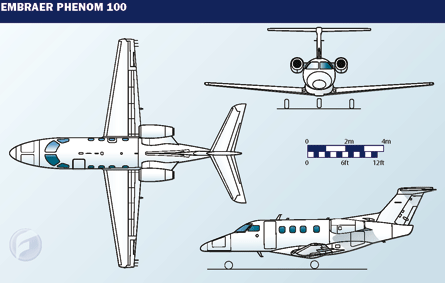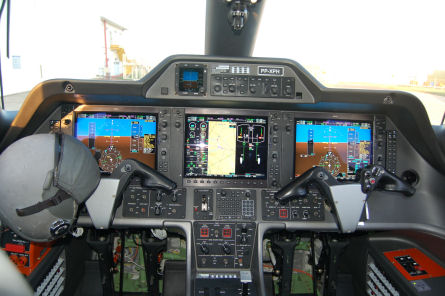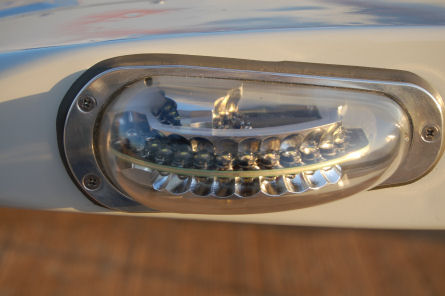For an aircraft at the low end of Brazilian manufacturer Embraer's burgeoning product spectrum, the Phenom 100 very-light jet is the beneficiary of a great deal of high-end attention.
From the automated engine start sequence to the filament-free lighting system, the airframer's focus from the outset has been to build an aircraft that will be safe and easy to operate and maintain, while offering airline-calibre dispatch reliability.
The design philosophy will be put to the test around the middle of next year when the first Phenom 100 is delivered and goes into service, supported by three Embraer-owned service centres and 20 company-authorised service facilities in the USA.
That first owner and hundreds of others who have already signed contracts for the $2.98 million twinjet or its larger sibling, the Phenom 300 light jet, will benefit from lessons learned in Embraer's airline business, where dispatch reliability is paramount. For more than a decade the company has been keeping regional and mainline carriers content with aftermarket support for nearly 1,200 ERJ and E-Jet regional jets built and delivered to more than 30 airlines in 20 countries since 1996.
The focus on the Phenom is part of a broader effort within the company to gain a significant market share in the executive-jet segment over the next 10 years. Its lone entrant at the moment is the $25 million Legacy 600, an ERJ-135 derivative that claims about 14% of the super mid-size niche.
The Phenom twins will headline Embraer's push to capture 30% of the light and very-light market in the next decade, a sector the company expects to account for 23% of a predicted 11,116 executive jet deliveries and 4% of sales by value in the period. The company is unveiling, but not launching, new mid-size and mid-light jet concepts at the National Business Aviation Association show in Atlanta this week.
Commercial pedigree
Despite being a bookend on the low side of a business aviation product range that tops out with the $41 million Lineage 1000 - a derivative of the E-190 airliner - the Phenom 100 has a pedigree generally reserved for much larger and more expensive commercial aircraft and business jets.
Although officially launched in May 2005, the VLJ programme started several years earlier as an effort to bring Embraer's regional aircraft expertise to the air taxi market, says Henrique Langenegger, vice-president for executive jets. The idea later evolved into an aircraft that could also be owner-operated, but in either case the intention was to have a platform that would provide passengers with the room and comfort of an airliner, and pilots with a docile, easy-to-fly jet.
Physics, along with a desire for commonality in style with the existing product line, largely influenced the external shape of the Phenom 100. Embraer decided the side-by-side engines, later selected as 1,615lb-thrust (7.2kN) Pratt & Whitney Canada PW617F turbofans, would be at the rear of the aircraft, requiring a T-tail. A target maximum operating Mach number (MMO) of 0.7 meant that a "straight" wing, which would eliminate the need for winglets and simplify the design and manufacture, were acceptable. Although its leading edge is slightly swept, the wing is perpendicular to the fuselage at its quarter-chord point, and so officially a straight wing from an aerodynamic standpoint.
|
|---|
Confident engineers
Months of windtunnel tests in Brazil, the USA and Russia with a 1/6-scale model gave engineers confidence that the Phenom 100's design will deliver the promised 2,150km (1,160nm) range (NBAA IFR reserves and four 91kg occupants), 380kt (700km/h) cruise speed and 3,400ft (1,040m) take-off distance in the specifications. That confidence in part came from windtunnel tests for the E-170 and E-190 conducted in the same facility in Russia. Performance metrics from test flights of the E-Jets proved to be within 1% of those measured during windtunnel tests.
Engineers studied several nose shapes for the Phenom and decided to stay with the eye-catching profile of the Legacy 600, a design that is also optimal in terms of structure and weight, says Langenegger.
Trade studies analysing costs, weight and build-time resulted in a structure that is 80% metal and 20% carbonfibre composite by weight. Composites include the tail structure - a first for Embraer's jets - and rear pressure bulkhead, as well as the control surfaces, nose and belly fairings, rear pressure bulkhead and dorsal fin, which are replaceable units.
Tipping the scales in favour of composites in the materials trade study for the tail assembly was the combination of lighter weight and reduced labour. The vertical stabiliser and all moveable surfaces are produced as "one-shot" assemblies, says Langenegger, while the horizontal stabiliser is produced in multiple steps - the upper and lower skin, ribs and spars are made as separate assemblies then assembled into one unit.
Embraer paid particular attention to corrosion prevention in areas where aluminium support brackets and structures are attached to the composite surfaces, a common problem when dissimilar materials come into contact. Aluminium components on the Phenom 100 must go through a visual inspection for corrosion after 10 years, a period the manufacturer says is longer than typical.
The Phenom 100 cabin, designed by BMW's DesignWorks USA, will come in three seating arrangements with seven options for the cabin amenities, including three types of finishes on cabinets, all produced and installed at Embraer's Gaviao Peixoto facility in Brazil. This is also the location for final-assembly and customer acceptance of the Phenom twins. Structural subassemblies for the VLJ, designed using Dassault's Catia V5 software, will be produced at the company's Botucatu plant, also in Brazil, where automated machinery will install nearly three out of every four rivets.
Interior surfaces in the cabin will be capped with either light-coloured or dark-coloured simulated wood or lacquer-like finish, depending on customer preference. Seats come in four different leather options and can be configured in a limo version, with six forward-facing seats and no lavatory in the back an air taxi variant with four forward-facing seats as well as the lavatory and a business version with two forward- and two aft-facing seats and rear lavatory.
In both lavatory versions, the toilet can be set off from the cabin with a rigid door, says Langenegger. Key to roominess in the 8.7m3 (305ft3) cabin is Embraer's "oval light" cross-section design, an enhancement that allows for 150mm (6in) more leg- and foot-room with little structural or performance penalty.
Bags of space
The aircraft has 1.55m3 of baggage space, with 1.27m3 non-pressurised storage area in the aft fuselage, accessible through an external door on the aft fuselage, enough for two pairs of skis or four golf bags.
Externally, the Phenom 100 features a trailing link main landing gear with single tyres, hydraulically driven extension and retraction system, and brake-by-wire and anti-skid controls passed down from the ERJ-145 and Legacy 600. The slotted Fowler flaps are electrically actuated, as are the trim tabs for roll, pitch and yaw. There are no slats, spoilers and thrust reversers, nor is there an auxiliary power unit. For simplicity, all flight controls are mechanically cable driven.
The horizontal stabiliser was sized for a wide allowable centre-of-gravity range, permitting a single pilot up front with full passengers and luggage in the back. "We looked at all combinations so we wouldn't have to impose weight restrictions," says Langenegger. Embraer is planning to introduce pilot and co-pilot side-mounted Class 2 electronic flight bags on the Phenom six months to a year after entry into service, with software that will perform weight and balance calculations on data input by the pilot.
Also on tap for in the same timeframe will be electronic checklists and a paperless cockpit featuring Jeppesen charts on the multi-function display and/or EFBs. Another future upgrade, set for six months after service entry, will be the ability to send aircraft and engine health information from the onboard central maintenance computer to Embraer's ground-based analysis system through the Iridium satellite network or through wi-fi datalink when on the ground.
The cockpit features Embraer's "Prodigy" flightdeck, an integrated package built around Garmin avionics. The system includes three Garmin G1000 12in flight displays - a primary flight display for each pilot and a multifunction flight display in the centre - which present attitude information captured by dual integrated solid-state attitude and heading reference systems and dual reduced vertical separation minima-compliant digital air data computers.
Systems monitoring
On the MFD are systems monitoring and flight planning functions including an engine indication and crew alerting system with full-screen synoptic displays and centralised maintenance monitoring functions.
Garmin also provides the aircraft's Mode S transponder with integrated traffic information service terrain awareness system XM Satellite weather datalink and audio digital weather radar with horizontal and vertical scanning capability and dual radio modules with 8.33kHz channel spacing. Pilots access the flight management system and communications and navigation radios through a panel-mounted alphanumeric keypad. Standby attitude, altitude and speed are provided in single display built by Thales.
The Phenom 100 has a Garmin GFC700 digital three-axis, dual-channel "fail passive" autopilot with roll, pitch and yaw control as well as automatic pitch trim and Mach trim. A fail passive system maintains the aircraft's trim position, but gives control back to the pilot if a failure occurs.
 |
|---|
Lighter workload
Full-authority digital engine controls on the PW617F engines, and links between the Phenom 100's integrated avionics and various aircraft subsystems, allow for significant reductions in pilot workload, says Embraer. Apart from taxiing, getting the Phenom 100 into the air requires few actions on the pilot's part. After turning both batteries on and inputting the flight plan into the flight management system, either by hand or with a flash card, the pilot turns two "keys", one to start each engine. Fuel pump controls, hydraulic systems, generators, air conditioner and bleed system functions for the pressurisation are managed automatically.
After typing in the required "V speeds" for take-off into the MFD via the keypad, to set electronic "speed bugs" on the airspeed tape in the PFD, the pilot sets the airport's ambient temperature in the FADEC for its power computations, sets the flaps, selects lights, sets anti-icing controls and advances throttles to the detent for take-off.
The pressurisation automatically follows the flight profile set in the FMS and the hydraulic system automatically configures and regulates itself. Prodigy will also reconfigure subsystems after certain failures in the electrical system and will otherwise show the pilot what has gone wrong via a synoptic display on the MFD.
For the en-route phase, the GFC700 autopilot has a built-in "cruise control" that provides limited throttle authority through the FADEC to hold speed, a feature particularly useful when cruising near MMO or speeds dictated by air traffic control, says Embraer.
Pilot-controlled icing protection includes electric windshield heaters, pneumatic wing and horizontal stabiliser boots and bleed-air heating of the engine inlets. The pneumatic boots, once activated by a switch on the panel, automatically cycle thereafter. Pilots determine if ice is present by observing an LED-lighted probe on the nose or checking the wing leading edge, which is lit by an incandescent light.
Human-factors engineering at Embraer played a key role in design of both the flightdeck in terms of the placement of information within displays as well as where the knobs and switches are located. Embraer designed the panel so that if "you're dark, you're ok", says Alexandre Figueiredo, senior manager of Phenom programmes. Rotary switches are set so that the 12 o'clock position corresponds to "automatic" mode, and when any applicable switch is not in the automatic mode, it is visually apparent and a message will also be displayed in a window of the pilot's PFD.
Messages that do not require immediate action are inhibited and will appear at a more appropriate time, for example after climbing through 400ft for errors that occur on take-off, while some other faults are only be displayed after landing.
In the maintenance area, human factors and lessons learned from previous programmes were implemented in the design of the Phenom 100 to make the aircraft easier to maintain and service over its expected 35,000h or 35,000-cycle lifetime, maximising availability for operators. Innovations include a lighting system that is filament-free, except for the single incandescent bulb lighting the wing leading edge for icing inspections. "Light bulbs burning out was the biggest complaint from executive jet owners," says Langenegger. The aircraft's landing lights, one on each side of the fuselage in the wing/fuselage fairing, are high-intensity discharge devices. All other lights are LEDs.
Interchangeable displays
The G1000 displays are all identical and interchangeable with an architecture that will allow Embraer to dispatch the aircraft with one screen not working, providing the display in front of the pilot is functioning correctly.
All the antennas and windshields can be replaced from the outside without having a technician inside the aircraft, innovations that allow for one mechanic to do the work as opposed to two. Avionics electronics boxes are installed inside the pressurised portion of the aircraft where temperature and humidity are controlled, leading to longer equipment life.
If the non-redundant flap actuators should fail during a revenue flight, Phenom 100 mechanics can help pilots finish the day's work by retracting the flaps by hand via an external mechanism on the wing. Embraer plans to certify the aircraft with a minimum equipment list that includes provisions for zero-flap operations, scenarios that will be achievable as long as the extra runway length required for no-flap landings and take-offs are available.
Figueiredo says Embraer began thinking about such minimum equipment lists early in the design, as part of an airline-type mentality to maximise utilisation of the aircraft. Along with a backup for flap retraction, the company also installed interconnected main and backup electric pitch trim tabs, one on each of the two elevator surfaces, allowing for continued operations if one actuator should fail.
For mechanics, lessons learned from previous programmes resulted in the incorporation of foolproof electrical connectors in certain areas, says Figueiredo. Examples include the four electrical connectors for the FADEC, which can only be mated to the correct connectors on the aircraft side, and the connector for the LED-lit red beacon on top of the fuselage.
Single point of contact
Embraer plans to have its three US service centres up and running when the first aircraft is delivered next year. Along with scheduled servicing and service bulletin and airworthiness directive work, the facilities - at Williams Gateway airport in Mesa, Arizona Fort Lauderdale, Florida, and at Bradley International airport in Windsor Locks, Connecticut - will feature back shops for composite, controls and sheet metal repairs. The company will for the first time be the single point of contact for the entire aircraft, including the engines.
Embraer plans to have $5 million in spare parts stocked at the facilities at service entry and is focusing most intensely on a subset of "critical" rotables that are most likely to present problems. Embraer has also contracted with cargo carrier UPS to store Phenom 100 materials in an Embraer-rented warehouse at its hub in Louisville, Kentucky, for next-day shipment anywhere in the USA. The company is contemplating one additional satellite warehouse location in the USA for parts, and is assessing having a dedicated aircraft to expedite parts to grounded aircraft. Embraer says it will begin signing aftermarket support contracts with supply-chain vendors early next year.
The Phenom 100 will have a three-year warranty period. Extended coverage to five years as well as additional scope will be availble under Embraer Executive Care, a power-by-the-hour type support programme, with two levels of service, standard and enhanced. Prices are not yet set.
The P&WC engines will have a 1,750h hot-section inspection requirement and a 3,500h time limit for removal and overhaul if managed under an "unconditioned" plan. Using an "on-condition" programme, where maintenance is based on performance, not the calendar, hot-section inspections will be increased to a maximum of 5,000h and engines will not have to be removed until 10,000h. With on-condition maintenance, operators monitor critical engine trends, such as oil pressure, for changes indicative of a problem. The trade-off for keeping the engine on-wing for longer, however, is that the operator must spend more time and effort in monitoring the engines, a task Embraer plans to help out with when the real-time maintenance downlink system becomes operational late next year or in 2009.
|
|---|
Certification on track
Certification of the Phenom 100 is on track for mid-2008, with flight testing under way using the first two certification aircraft, both built on production tooling. In all, Embraer will use three aircraft to complete the Federal Aviation Administration and European Aviation Safety Agency certification programme, accumulating about 1,200h of flight testing, 300h of which will be for function and reliability testing ahead of service entry. A fourth aircraft will be used for 600h of "maturity" tests in various weather conditions to ensure that all issues have been uncovered when the first customer aircraft is delivered - an internal Embraer requirement. A fifth aircraft will also be built and used as a marketing demonstrator.
The company is also building full-scale test articles of the Phenom 100 for static and fatigue testing and had previously built test rigs for avionics, electrical distribution and other functions to build maturity and minimise downstream risks to schedule.
As of mid-September, flight testing of the first Phenom 100 was on schedule, with exploration of the full flight envelope, including stall characteristics, completed. Embraer plans to produce between 120 and 150 Phenoms a year, once Phenom 300 light jet production begins in 2009.
Source: Flight International






















